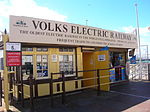St Mary the Virgin, Brighton
19th-century Church of England church buildingsChurch of England church buildings in Brighton and HoveChurches completed in 1879Grade II* listed buildings in Brighton and HoveGrade II* listed churches in East Sussex

St Mary's Church is an Anglican church in the Kemptown area of Brighton, in the English city of Brighton and Hove. The present building dates from the late 1870s and replaced a church of the same name which suddenly collapsed while being renovated. The Gothic-style red-brick building, whose style resembles Early English revival and French Gothic revival, is now a Grade II* listed building, and remains in use despite threats of closure.
Excerpt from the Wikipedia article St Mary the Virgin, Brighton (License: CC BY-SA 3.0, Authors, Images).St Mary the Virgin, Brighton
St. James's Street, Brighton Kemptown
Geographical coordinates (GPS) Address Nearby Places Show on map
Geographical coordinates (GPS)
| Latitude | Longitude |
|---|---|
| N 50.820277777778 ° | E -0.12944444444444 ° |
Address
St Mary's Church Hall
St. James's Street
BN2 1PJ Brighton, Kemptown
England, United Kingdom
Open on Google Maps








